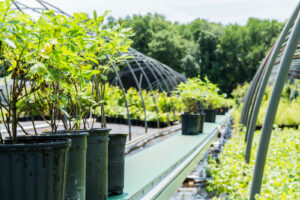
It’s time to start ordering your native plants for fall planting!
As summer is waning and thoughts are turning to fall foliage, it is easy to assume your gardening is done till next spring. However, fall is still a good time to plant and re-energize your native plants.
Make a Planting Plan
Start by making a plan of what you want to plant, and where and when. Remember that new plantings are tender, so just like in the spring, they need extra care. High daytime temperatures can damage them, so try planting in the early hours of the morning. If you can, do the planting on overcast days, when the humidity is up and the sun is less intense. Spend most of September planning, including spending time in your garden each day to see what your fall sunlight is like, then get the planting done in late September and early November.
Mud-in And Mulch Over
When you are doing the planting, place each plant in its new hole and water it two or three times before adding a mixture of compost and dirt to fill the hole. Once the plant is covered, water it again a few times to make sure it is really saturated (mud-in). This helps ensure that the air bubbles are forced out of the soil and helps with over-wintering. Once the plants start to die back in the cooler weather, mulch over and around the perennials to protect them from the winter cold.
Remember Your Veggies
Just because it is fall, doesn’t mean your veggie patch is done. Consider a selection of short season, cold hardy crops, like heirloom lettuce, spinach, and radishes. Waiting longer to harvest root vegetables makes them taste sweeter, so you should also consider leaving some of those for later harvest.
Get Your Bulbs In
As you’re making your fall planting plan, leave room for spring-blooming bulbs. Most of these need a cold dormancy period to really produce when they bloom in the spring, so you need to plant them in the fall. Plant them according to your zone, but make sure they have enough time to get established and go dormant over winter.
Consider the Trees
It can be scary to consider planting a large tree or shrub before winter since the storms and cold weather could damage it. However, planting in the fall has a higher success rate and the fewer maintenance needs because there is more rain and the cool weather keeps the roots moist. Go for it!
VISIT AMERICAN NATIVE PLANTS
Whether you’re looking to restore a local wetland or beautify your property, American Native Plants can provide you with the right plants for the job. With an inventory of over 400,000 native trees, native shrubs, and herbaceous plants consider American Native Plants your one-stop shop for wholesale native plant needs. Peruse our catalog, give us a call, and follow us on Facebook, Twitter, and Google+!
